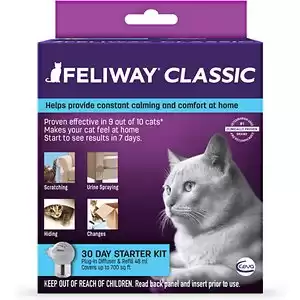Cats can be fussy animals. Although we’d like to believe that they’re angels all of the time, on occasion we have to admit that they’re more similar to ambulance sirens – and maybe that’s understating how grating they can be. This can pose a problem for people living in apartments because since the individual living units are closer together, depending on how well the apartment is soundproofed, there are times when your neighbors might hear your cat as well.

This can be a huge source of stress for sound-sensitive people and people that want to avoid any conflict between neighbors or landlords. Especially in places that aren’t too fond of animals around.
Cats can be loud in a couple of ways. In an apartment with multiple cats – it’s very likely that they’ll chase each other around and sometimes rough-house. This can cause some rumbles and shakes from time to time but it is nowhere as grating as incessant meowing or vocalizations.
So are cats loud in apartments? There are times that your cat might be loud or vocal about something that they desire. Therefore, understanding why they might be vocalizing or meowing might allow cat owners to satisfy their needs quickly, minimizing habitual vocalizations. Some cat breeds are also known to be much quieter and more reserved in their calls and vocalizations, therefore for new cat owners, it’s a good idea to consider some of these cat breeds if they’re sensitive to sounds.
Although it can be annoying, we have to understand that a cat is only vocal when they’re trying to communicate with us. Trying to understand rather than becoming angry and annoyed is the best way to approach it.
For people that are struggling to get to sleep because of their wild cats at night time and need a simple, outlined method to stop the behaviors, click here!
Three Huge Reasons a Cat Might Be Loud and Vocal
There are three main reasons why a cat might be vocal – the first two are more obvious and the third not so much.
The three reasons are:
- Hormonal and reproductive calling and vocalizations
- Aggression, stress, or anxiety
- Desire for something **
Generally, the first two are simple enough to recognize and prevent. As long as your cat(s) are spayed/neutered have a good relationship with you, and/or other animals in the home – they likely aren’t meowing or calling because of this.
The third reason, the desire for something stems from boredom or hunger. The thing that makes it a bit more difficult is that the vocalizations can vary between cats and cat breeds. That’s why observing your cat and being aware of your cat’s environment is an important skill to have as a cat owner. You can better pinpoint the stimulus and act accordingly.
What Do Each Cat Vocalizations/Meows Mean?
According to a study conducted in 2019 about Feline Vocal Communications, the vocal repertoire of a cat contains up to 21 different meows and vocalizations. The study notes that the environment has an important impact on the vocal behavior of a cat as pet cats and feral cats can vocalize differently.
Below is a chart on some of the common types of adult cat vocalizations referenced from the study above.
Vocalizations with ** are important ones that we have to be aware of in an apartment.
| Vocalization | Description of Vocalization | Meaning/Context |
|---|---|---|
| Yowl | Long, drawn-out vocalizations with variable pitch, intensity, and tonality | Reproductive, hormonal influences |
| Chatter | Jaw vibration, creating low amplitude taps or chatter | Desiring prey when out of reach or difficult to catch |
| Growl | Low pitched, throaty, growls | Mild aggression and warning |
| Shriek | Short intense cries and yells. Hoarse with strain on the mouth and throat. | Active fighting or sudden pain |
| Trills ** | Vocal garnishment, produced with some sort of vibration or purr | Greeting or desire for something |
| Tweedle ** | Prolonged chirp or tweet with some voice garnishment (like a trill) or modulation | When something is desired |
| Tweet ** | Soft weak chirps, very airy | When something is desired |
Some cats might only do a couple of these vocalizations and other cats will do all of them and some cats can create new vocalizations of their own. For example, a Bengal cat can create sounds that you’d never thought possible from a cat. It can vary widely but the above is a good reference point for what a cat is trying to communicate.
How to Make Cats Stop Meowing or Vocalizing
If you find yourself noticing that your cats are trilling, tweedling, or tweeting very often and loudly (maybe at certain times in the day) – then that indicates a desire. The question is what sort of desire?

Here are the most common situations for a cat to vocalize their desires:
- They’re hungry – straightforward and easy to solve. If your cats have mealtimes and they know when their mealtimes are, they’re going to remind you that it’s time to eat. Cats that are free-feeding or without mealtimes don’t have this natural feeding clock, therefore, maybe making them constantly asking for food.
Solution: Don’t free-feed cats and stick to mealtimes with correct portions. - They want to get somewhere, usually a room the butler is in. General attention-seeking behaviors. they’re Tlooking for you to be the stimulus and to do something with them. Basically, they’re bored. Keep track of when they start calling, it’s usually at the same time every day. For example, many of my cats become a bit restless before bed and if I’m in the other room, they’ll call very loudly and for quite long periods of time (10-20 minutes) if I don’t respond.
Solution: Take note of the times that they start being vocal and introduce play-time in that section of the day. Make it a routine to do it regularly and in no time – your cat will stop being the ‘little sirens that could’. - They’re bored and restless – Like above, think about their vocalizations as a sign that they’re bored. It’s possible that in addition to vocalization, that they start messing around with items that they’re not supposed to. Knocking things over, getting into cabinets, or just being a menace.
Solution: Notice the time and part of the day that they vocalize or become restless. Introduce playtime or some sort of activity with your cat that allows them to expend their mental and physical energies. For those people looking for exercises and activities for your cats to do in apartments, read here!
The key is to be proactive – if you notice that your cat(s) are being overly vocal or loud, keep them satisfied/tired out before they become loud!
Which Cat Breeds are Quietest?
Some cat breeds are just naturally quieter than others. Usually, it’s the higher energy breeds that are more vocal than the relaxed, passive cat breeds.
The top 5 quietest cat breeds (follow through the links to see comprehensive guides and tips for the specific breeds):
- Ragdoll
- Exotic Shorthair
- Persian
- Scottish Fold/Straight
- Russian Blue
Which Cat Breeds are the Most Vocal?
These are the breeds that cat owners want to avoid if they want to live with the quieter type of lifestyle. They’re usually the more active cat breeds with a ton of energy.
The top 5 most vocal cat breeds are (follow through the links to see comprehensive guides and tips for the specific breeds) :
Recommended Tool to Reduce Meowing or Vocalizations
If your cat is meowing because of stress or fear or adjusting to a changing environment. This is a product that helps to calm cats that are vocalizing because of the factors above by using familiar pheromones.
 Feliway 30 Day Starter Kit
Feliway 30 Day Starter Kit
Feliway is a synthetic copy of the feline facial pheromone, used by cats to mark their territory as safe and secure. By mimicking the cat’s natural facial pheromones, Feliway creates a state of familiarity and security in the cat's local environment. As a result, Feliway can be used to help comfort and reassure cats while they cope with a challenging situation and help prevent or reduce the stress caused by a change in their environment.
